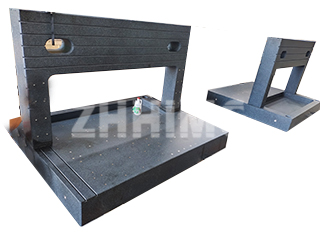In the world of metrology and precision assembly, the primary focus is, rightly, on the flatness of the granite platform’s working surface. However, manufacturing a truly high-quality, durable, and safe surface plate requires attention to the edges—specifically, the practice of chamfering or rounding them.
While not directly impacting the sub-micron accuracy of the working plane, the chamfered edge is an indispensable feature that significantly enhances the plate’s longevity, protects valuable measuring equipment, and ensures the safety of the technician. It is an essential element of modern, professional granite manufacturing.
The Necessity of Breaking the Edge
Why do manufacturers deliberately remove the sharp, 90∘ corner where the working surface meets the side face of the granite slab? It boils down to three core reasons: durability, safety, and functionality.
1. Preventing Chipping and Damage
Granite is incredibly hard, but this hardness also makes the sharp, unsupported edge brittle and susceptible to chipping. In a busy manufacturing or calibration lab, movement is constant. If a heavy gauge, a fixture, or a tool accidentally bumps against a sharp, untreated corner, the impact can easily cause a chip to break away.
- Protecting the Investment: A chamfered (or rounded/radiused) edge creates a robust, sloped buffer zone. This “broken edge” effectively distributes accidental impacts over a larger surface area, dramatically reducing the concentration of stress and the risk of chipping. Protecting the edge means protecting the structural integrity and the aesthetic value of the entire plate.
- Preventing Burrs: Unlike metal, granite does not develop burrs, but a chip or nick can create an uneven surface that can snag cleaning cloths or pose a hazard. The rounded edge minimizes these potential fault lines.
2. Enhancing Operator Safety
The sheer weight and sharp, natural edges of a massive granite slab pose a serious hazard. Handling, transporting, and even working next to an un-chamfered plate is risky.
- Injury Prevention: A sharp, finely finished granite edge can easily cut or scratch a technician. Edge breaking is first and foremost a safety measure, removing the potential for injury during setup, calibration, and daily use.
3. Improving Functional Longevity
Chamfering aids in the general use and maintenance of the plate. It facilitates smoother movement of covers and accessories and simplifies the application of protective coatings or edge tape. A clean, finished edge is a hallmark of a professional-grade metrology instrument.
Selecting the Right Specification: R-Radius vs. Chamfer
When specifying an edge treatment, manufacturers typically use a radius designation, such as R2 or R3 (where ‘R’ stands for Radius, and the number is the measurement in millimeters). A chamfer, or “bevel,” is technically a flat, angled cut, but the terms are often used interchangeably to refer to any broken edge. In precision granite, a rounded radius is usually preferred for superior chip resistance.
Understanding R2 and R3
The choice of specification, such as an R2 or R3 radius, is primarily a matter of scale, aesthetics, and handling.
- R2 (Radius 2 mm): This is a common, subtle, and functional radius, often used on smaller, highly precise inspection plates. It provides sufficient safety and chip protection without being visually dominant.
- R3 (Radius 3 mm): A slightly larger radius, R3 offers enhanced protection against heavier impacts. It is frequently specified for larger surface tables, such as those used beneath Coordinate Measuring Machines (CMMs) or other heavy equipment, where the risk of accidental side impact is higher.
The radius does not follow a strict industry standard (like the ASME flatness grades) but is chosen by the manufacturer to be proportionate to the plate’s overall size and intended working environment. For large-scale precision granite, ensuring a consistent, well-polished R3 edge is an investment in long-term durability and shop floor safety.
Ultimately, the small detail of an R-radius edge is a powerful indicator of a manufacturer’s commitment to quality that extends beyond the flat working surface, ensuring that the entire platform is durable, safe, and built to last.
Post time: Oct-14-2025

